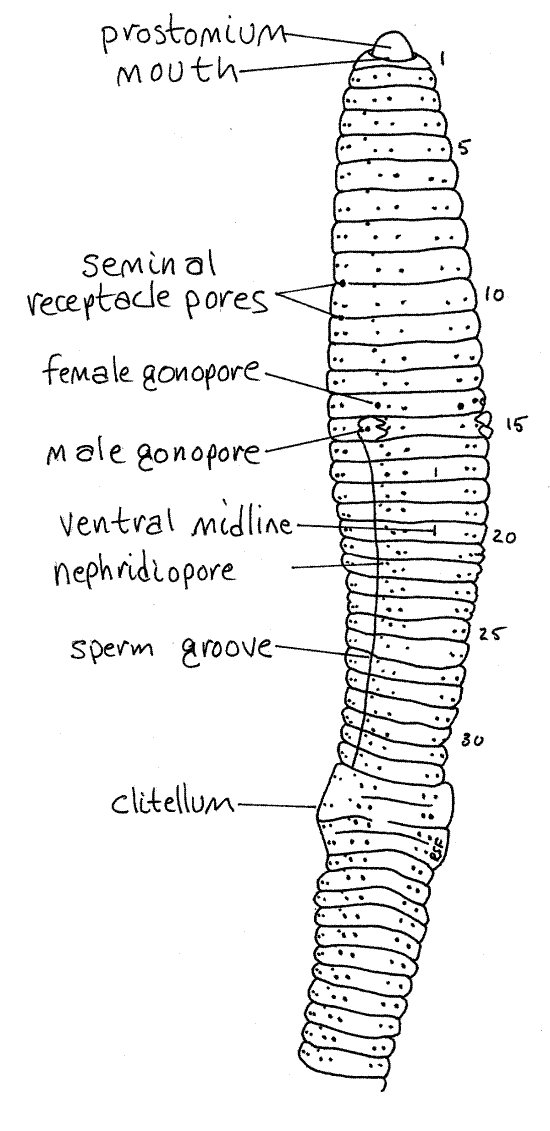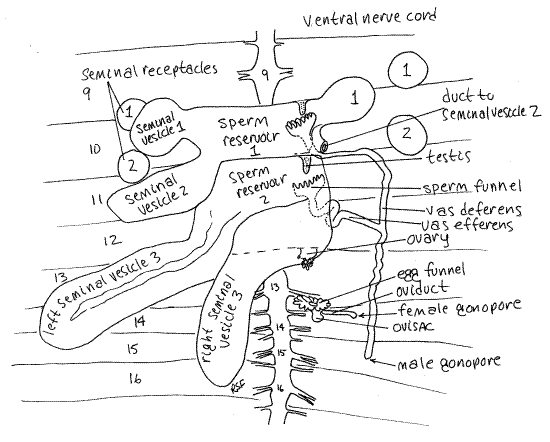Richard Fox's diagrams will come in handy when reading the description below:
For a detailed analysis, with dissection notes, consult: http://lanwebs.lander.edu/faculty/rsfox/invertebrates/lumbricus.html
Also, it would be helpful to read through Michael Lazaroff's site, likewise containing dissection notes and diagrams: http://shs.westport.k12.ct.us/mjvl/biology/dissect/earthworm.htm
Like slugs, earthworms are hermaphrodites, meaning they possess both male and female sex organs and they can all lay eggs. Now, when earthworms prepare to mate, they come alongside each other, facing opposite directions. In order for copulation to take place, each worm's clitellum (a swollen band near the front of the worm, covering segments 31 or 32 to 37) must line up with its partner's male sex cells on segments 9-11, where the seminal receptacles (belonging to the female system) are located (on 9 & 10). Both worms secrete an enormous amount of mucus which forms a tube of slime about their bodies from segments 9 to 37. First the sperm pass through ducts from the male sex cells on segments 9-11 to two male gonopores on segment 15. The sperm are then ejaculated from the gonopores and carried backward in tubes (created by the grooves on the worm's body being covered by the slime tube) and are deposited in the partner's seminal receptacles on segments 9 & 10.
Now, the each worm's clitellum also produces a slime tube. Eggs are released from ovaries on segment 13, through the female gonopores into egg sacs in segment 14. So, as the slime tube produced by the clitellum travels forward towards the front of the worm, it collects the worm's own eggs from the sacs in segment 14. It then continues to move forward until it reaches the seminal receptacles on segments 9 & 10. At this point the sperm received from the other worm fertilizes the worm's own eggs, all within the slime tube. After fertilization, the tube slips off the worm's head, seals at both ends, and becomes a lemon-shaped cocoon containing 4 to 20 eggs. The cocoon remains in the soil for about 2 to 3 weeks, and then the baby worms hatch, emerge from the cocoon, and wriggle into the soil.
Here is an simple illustration of how this works:
 |
| http://www.robinsonlibrary.com/science/zoology/annelids/earthworm.htm |
Resources:
http://science.howstuffworks.com/zoology/all-about-animals/earthworm3.htm
http://www.backyardnature.net/earthwrm.htm
http://lanwebs.lander.edu/faculty/rsfox/invertebrates/lumbricus.html
http://www.naturewatch.ca/english/wormwatch/about/ecology.html
http://www.vermica.com/all_about_worms.htm














No comments:
Post a Comment